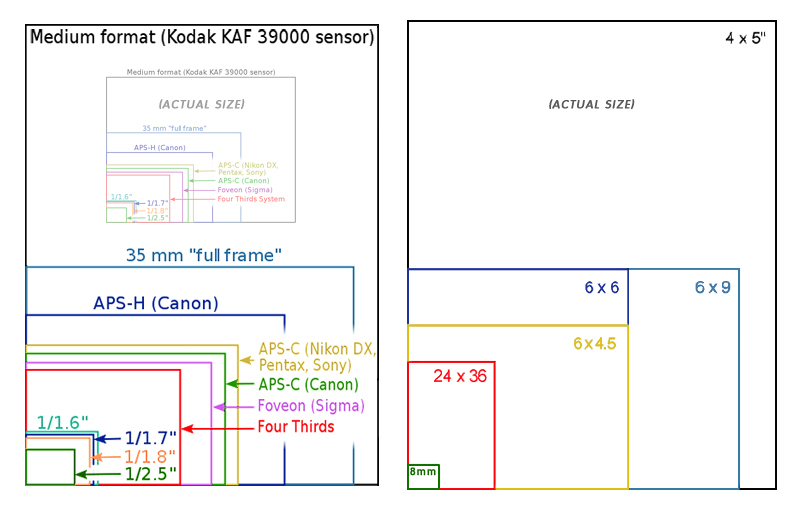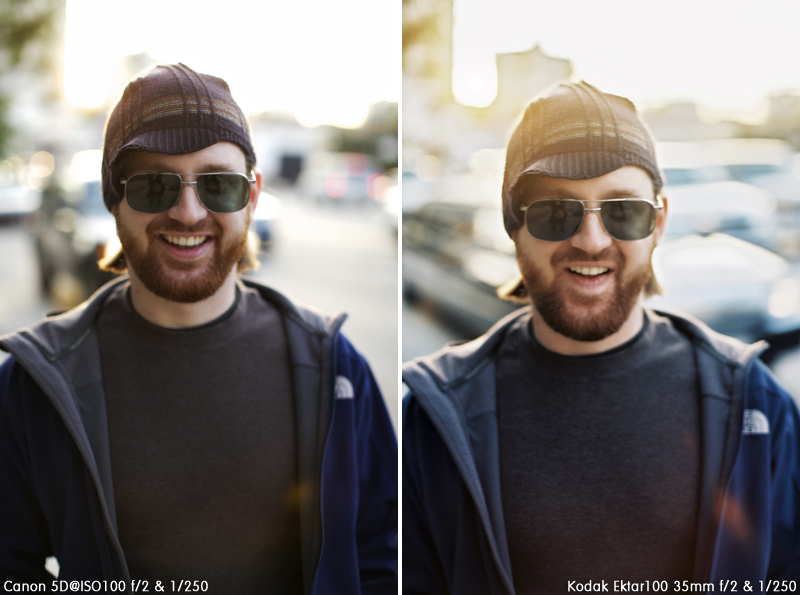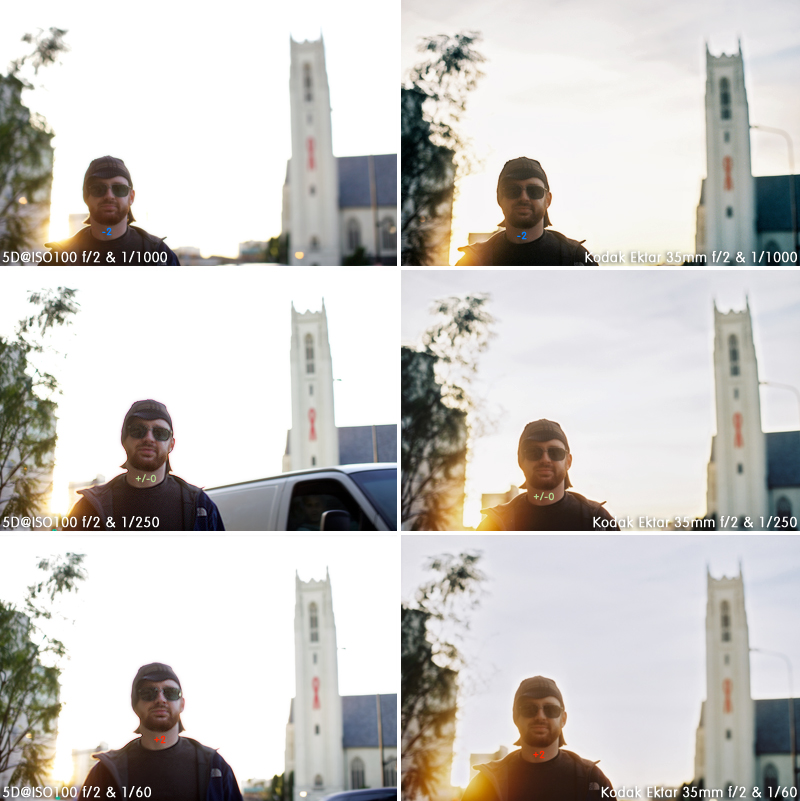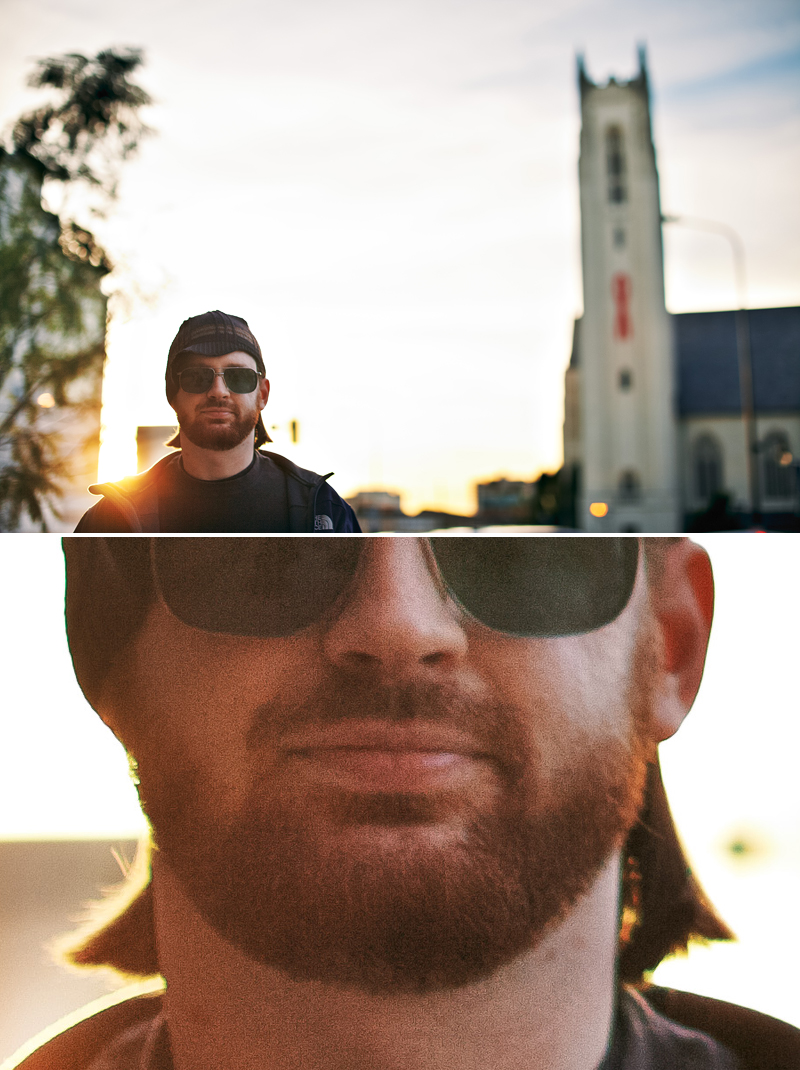skip to main |
skip to sidebar
After doing our last digital vs. film test we received several questions from followers wondering why we didn't compare a full frame digital capture to 35mm film or 645 film to a $30K digital back. The simple answer was that we were simply comparing the capture mediums, not cameras. The easiest way to do that was to use smaller format pro-sumer cameras. At the time many enthusiasts and "Professional" photographers were still shooting the D300 and other cameras like it (I still think the smaller sensor size has an advantage when shooting telephoto zooms). For those pro photographers shooting 6cm film that went digital, most have opted for, or later upgraded to, a full frame sensor. But the medium format backs have been predominantly (due to numerous practicalities) reserved for 4x5 and studio shooters. In context, the 645 format is really a relatively small format for film. The largest you can go with a great digital back is about 6x4.5 but with film you can go all the way up to 8x10 or even larger. The smallest serious digital format is M4/3, but with film 35mm is lowest quality available. There was also the price gap between a Nikon F3 and a Canon 5D Mark II. Not even in the same ballpark. In the end we felt we chose two easily accessible formats to compare.
It would seem a fair assessment, that digital sensor sizes scaled to film sensor sizes, tend to line up in accessibility, application and functionality of each medium pretty accurately...

That being said, recently we talked a friend into letting us borrow her 5D Mark II and we decided to do the test all digital photographers really wanted to see... Full frame digital vs. full frame 35mm film! So here it is!

Above you can see Matt really enjoying having us point our cameras at him. :) Thanks Matt! On the left is the Cannon EOS 5D Mark II with a 50mm f/1.2 L shot RAW at ISO 100 and on the right our little Nikon FE2 with a 50mm f/1.2 AI-S loaded with Kodak Ektar 100. Both were exposed identically metering for Matt's face. The digital was edited in Aperture to maintain optimal latitude, color and contrast. The film is a straight scan made on our Fuji Frontier SP-2500. The output at 300 DPI is 10 inches in width (conservatively 14MP), so we scaled in a little on the negative when scanning to match the 21MP (about 12 in.) resolution of the 5D.
There are some definite differences in the overall look of the two images. I love the color of the Ektar! Skin looks great! The digital appears to fall just shy of the highlight detail of the film. Detail is definitely lost in the background but the transitions look much better than other digital cameras. The Ektar is a very contrasty negative stock but it still performs rather well under intense lighting.
Next, exposure forgiveness... The series below were shot underexposed 2 stops, then normal exposure, and finally over 2 stops. (Digital hates it when we do that!)

No too surprising. Pretty self explanatory. The Raw files really handled the over and underexposure well in the soft light, but had little to offer in way of highlight detail in the sky even when underexposed 2 stops. The tree and the building above Matt's right shoulder are totally destroyed by the sun on digital, whereas on film, all the detail is retained in every exposure. Now take a look at the detail pixel for pixel.

On the right, film does really well with the harsh back light. The 5D has digital's signature neon glow. I could have spent time reducing noise and fringing but this is a capture test, not a digital post test. In regards to grain vs. noise, these two seem to go toe to toe and I'm sure everyone who sees this will have a different opinion on which is better so I'm going to stay out of it. The film grain appears a little larger but the film has no interpolation so therefore finer resolution. I will say that the beauty of film is that you can get 5X the resolution just by upgrading to a Mamiya C330 and Ektar in 120 and little to no cost! Not available for the Canon. You have to invest in a $30K digital back and a brand new camera! Either way, grain and noise this size would not be visible on any print under 16x20. What would be visible in a print would be the spectral highlights and interpolation you see around Matt's head where the highlights blowout on the digital shot. In our experience, film always looks better printed whereas digital tends to fall apart when you print it due to the aforementioned and the fact that gradients and color ranges that look great on your screen don't always look great in the print.
In the end I was actually blown away how good the 5D Mark II actually did! I have nothing but good things to say about this camera. I still love our film but later that night when we pushed some Kodak Vision 3 500T 3 stops to 3200 to compare to the Cannon's 3200 setting I was amazed at the performance.


These shots are straight out of camera! The 5D has a little built in color noise reduction and sharpening in camera but I didn't do anything about the noise in post. The 5D Mark II is just that good at ISO 3200! The 500T is amazing for being pushed 3 full stops in developing but didn't turn out to be true 3200. Maybe a halfway between ISO 1600 and 3200 and seeing that I can underexpose 500T 2 stops in low light without pushing and still only loose a little shadow detail tells me that pushing color film only increases your mid-tone and highlight levels. You may get a little more separation by bringing some of your shadows into the mid-tone range, thus getting images that look better exposed, but in the end you are not adding information to your negative. Color film pushed is only as good as the shadow detail of your film stock. I do prefer the look of the film shot better than the digital but at the cost of some speed and resolution.
In the end, I still can't see film becoming obsolete anytime soon. There are so many great cameras and film stocks out there at truly affordable prices that there is no reason for anyone not to get into it. On the other side, digital is very expensive and time consuming. To have the current top of the line digital gear we would have to sell almost all of our film gear. And we have a lot! But if you have the cash and are good at working in RAW and love spending time editing images on your computer the Mark 2 is probably perfect for you. But I say film is beautiful! If you get good scans you really don't have to do anything to it and it will look gorgeous.
So what are you waiting for? Go out and shoot some film, take it to Richard Photo Lab and tell me you don't love it!
Added 1/26/2011...
Our friend Zach Hodges saw this post yesterday and offered to put a few of the images from the Canon 5D Mark II through his normal work flow to see if he could improve upon the initial capture quality. So we sent a few over and here is what he had to say:
"I ran three of those through my usual assembly line. I tried not to spend more than a normal amount of time on it but I suspect I may have, about 7 mins a photo. As I suspected, there was some improvement to be made, but film obviously still destroys in the DR department. The f/2 and 1/1000 one was the only one that had recoverable highlights. Fringing was pretty easy to get rid of with a few clicks and skin tone is very subjective, but I took it to where I liked it."

This was the same raw file from above that was exposed 2 stops under. It looks much much better! But the film shot that was exposed 4 stops more (16X brighter highlights) than this one retained just as much highlight detail with zero post. Fringing is gone and color looks a lot better! Goes to show that good postprocessing makes all the difference with digital photography. Thanks Zach! :)












20 comments:
I always love your comparison testing of digital images versus film images, always an eye opener. As a person who shoots both film and digital I fully get the need to understand the limitations of each. I must say I feel best when I shoot a roll of film, especially for portrait or wedding work. When it comes to motorsports I will admit I am about 90% committed to digital due to the sheer number of images required to pull off an assignment.
can't say i understand it all but i am very glad i am shooting film these days :)
Great article, great to see film do so well at high speeds. The Ektar I think is nicer than the 5D, more detail, even a little sharper, which is strange. I'd expect the 5D to win at 3200, but I had no idea it would be so close with the 500T.
Not sure why people still shoot digital really. :-)
I think the chap's smile is better on film. Hope that helps :-)
The results are quite good for film shooters like myself... a higher res scan on say an Imacon would really show the advantages to the film with regards to subtle fine detail.
Cheers-
Stephen Schaub
Imacon scans? Sure they're better but a 5DMkII body costs £1,650 and an Imacon X1 (the cheap one) costs £10,000.
I shoot film and digital, and although I think the digital files here weren't processed brilliantly I agree with the basic conclusions.
Today's pro films are awesome. Scanning is still a problem for me though.
I spent 2 hours last night scanning 6 images with my Coolscan. *boo hoo*
Though the new Fuji frontier labs are now starting to do 18Mp scans off 35mm and a few enlightened labs making those available at a reasonable cost.
What we really need, and I am sure it's in the interests of both Kodak and Fuji is for the labs to be able to process ~20Mp scans at the time of developing for 135/110/220 without slowing down the lab. F & K should then strongly encourage all labs to provide those scans as standard and with minimal cost to film users. Surely that would boost film sales? It certainly would make me use film a lot more.
@Craig Arnold
Thanks for your input! I will not argue with the convenience of digital or that digital files may be processed to look differently (more or less brilliantly) based on taste and time spent in post. But I would disagree on a few things...
We picked up our Fuji Frontier SP-2500 for less than the cost of a 5D Mark II at the time. But we don't recommend getting one to most. Owning an Imacaon or drum scanner isn't really practical for hardly anyone. 13MP scans are plenty for the large majority photographers and you don't need to own a film scanner to get those. With digital you are told that you want as many Megapixels as you can get because frankly there is no way to go back and get more after the fact. With film your negatives and slides hold much more information than you need to have them scanned at. You can always get a drum scan made for a super large print and the information will be there. (Especially if you shoot 120 or large format.) You don't need to waste HD space by scanning everything at 20MP plus.
I pose a question... How many photographs did you shoot last year? Now how many of those did you print 16x20 or 20x24? Probably not many. Why are you scanning as if you were printing them all that size? Your RAW file is the film! You can always go back and export (scan) your image much larger.
With the frontier I can scan at least 10 rolls in 2 hours. (For the record I hate the coolscan!) If you go to a lab your time is cut to zero.
Fuji and Kodak are in the business of making great archival film that will last beyond your lifetime. They know how many of us print large. (Not many)
If you want to print every image you take at 16x20 or larger digital is there. Though you will have the issues mentioned in the post. But if you want to be able print MUCH larger than that but print most below 11x14 film is the choice medium.
@Brandon
Currently I get my film processed and scanned in the high street (Jessops). The "hirez" scan on the PhotoCD is 1Mp. And it's horrible. Not just low resolution but really poor quality: blown highlights, poorly focussed, just LOTS of problems. So even for Facebook where I don't need the resolution, the picture is a mess - almost unusably poor. So I HAVE to scan it again. Now sure I don't need to do that for ALL my images. But I do find that at least 35% have sufficient merit compositionally to warrant further work in LR or PS.
How many make it to final prints A4 size or above? Maybe 20 a month. I like prints, and I love digital printing with the range of papers available to us now.
And for a hybrid film/digital workflow it would really make an enormous difference if I could get scans as good as those from my Coolscan at the time of processing. At that point the hybrid workflow is not a great deal more problematic than simply shooting digital in the first place.
Also - I don't know about you but I cannot always tell what images are going to make it to print before I start working on them. A few are clear, but sometimes what I need isn't in the neg, but I have to first go through the Coolscan torture to find that out.
The difference between 13Mp or 20Mp scan isn't a deal breaker. But a poor 1Mp scan is, and unfortunately that's still what most of us have to live with from the high street.
I agree that I can always go back to the neg and get a drumscan if I ever make an award-winning image. But that's a whole extra level above my basic requirements.
@ Craig
1MP! Wow! That is terrible! I'm not sure where else you could go in the UK but find a place that works with real film professionals! Here in california you can get for $15-$20 film proceed and scanned at a good resolution with great quality.
I agree with the at least 35% are worth printing at least small for our work. That doesn't always happen and most personal work just ends up on the BLOG to be printed at a later date.
99% of the images we take aren't printed above 11x14 so our scans are plenty good for that.
Just find a place that can get you pro quality scans and you will only need your Coolscan for the few images above A4 size and you will know what images those are based on your good scans you already have.
After a quick search I found 2 pro labs you could look into. Just make sure they are scanning with either the Fuji Frontier or Noritsu and not the Agfa or something worse. Not bad prices but not cheep... You get what you pay for.
Peak Imaging - http://www.peak-imaging.com
Palm Labs - http://palmlabs.co.uk
Good Luck!
Hey cool I hadn't seen the update! Processing does make all the difference, and sadly I think very few people understand how to do it right. But, it's all so subjective, my right is someone else's wrong I'm sure!
Zach: And you my friend do know what it takes to refine a digital signal. It's sad to say, most people ruin their raw files in post. Almost as sad as it is that the photo labs nearly killed film!
Photography is a process, not just hinged on a technological medium.
Amazing post!
Thanks so much.
-Jay @iheartfilmphoto
Not sure if I've posted this already somewhere but I'll gladly drum scan the neg film for you (Howtek 4500 plus Aztek DPL Pro software). Would be good to see what more you can get out of the film..
@Tim Thanks for the offer! Maybe for a future test! :)
Digital is a bit like both slide and neg... you got no room for the highlights, but it looks very terrible underexposed when pulling the midtones back up.
Best case scenario in both worlds is to reduce exposure so you get better contrast/less flaring coming across from severely overexposing the bright background/backlit situation and light your subject up :)
Fantastic! Another wonderful blog showcasing the excellence of film!
Not been here for over a year.. its great to see you guys still doing your thing, promoting film, and taking fantastic images.
God bless!
S
very impressive results.some may find the digital should have been given more work.i like film 'cause i'm forced not to shoot a trillion pix.i hate the editing.i luv the cost factor but hate buying bigger memory drives and backup..
Had Hi-Rez files made last week off Fuji Frontier! Joy! nice part no work my side till i did truly minimal Photoshop.jason gold
Big catch…digital is a sure shot, easy to reproduce and much of the skill and understanding of how light works is redundant with digital. The camera compensates and further compensation is possible with software. You can sharpen afterward etc, you really don’t need to think or even know much of anything besides composition and how to be a better computer nerd.. Not film, you need time to learn and practice but when you can nail your shots, when you have the skill to instantly know how to squeeze all you can out of the film with that shot…then it beats digital otherwise, you will be like…uh digital beats film (said in homer Simpson voice). Also, if you have the ability to use super film like cms 20 for example or super developer like the FX series…you will actually be limited by the glass not the sensor, can you understand that? think about it. With film nowadays, you need to be able to develop and print yourself…forget scanning, use an enlarger, the quality is incomparable and also, this is when using film becomes much less expensive than digital. With the photography I do, street, landscape long exposure, portrait, B&W I would be crazy not to use film but that’s because I know how to.
And don’t fool yourself, that LCD is a crutch not a benefit, it slows you down numbs your mind and worst of all, you can’t do without it after. You know that scene from forest gump when he starts running in his mechanical legs and they fall apart and he runs faster and faster…yeah that’s how I felt when I broke free from the crutches of software, memory cards, cables, pixels, marketing, screens and computers…What it did to my photography is absolutely amazing and I just feel the need to make others try it as well.
If anyone is looking for a great film processing service in UK, I can recommend Photo Express (www.photo-express.co.uk). Prints or CD, or both, and choice of JPEG or TIFF files. Very speedy 48-hour return service. Excellent!
Justin
This is amazing side buy side !! Thank you !! I've been searching the interwebs for something like this all day ( < 2 hours ) but still very long for Internet searching. i haven't seen a better side by side !!!
Exactly what I was looking for, amazing post.
Thanks for this !
Jillianxeniaphoto.blogspot.com
Post a Comment